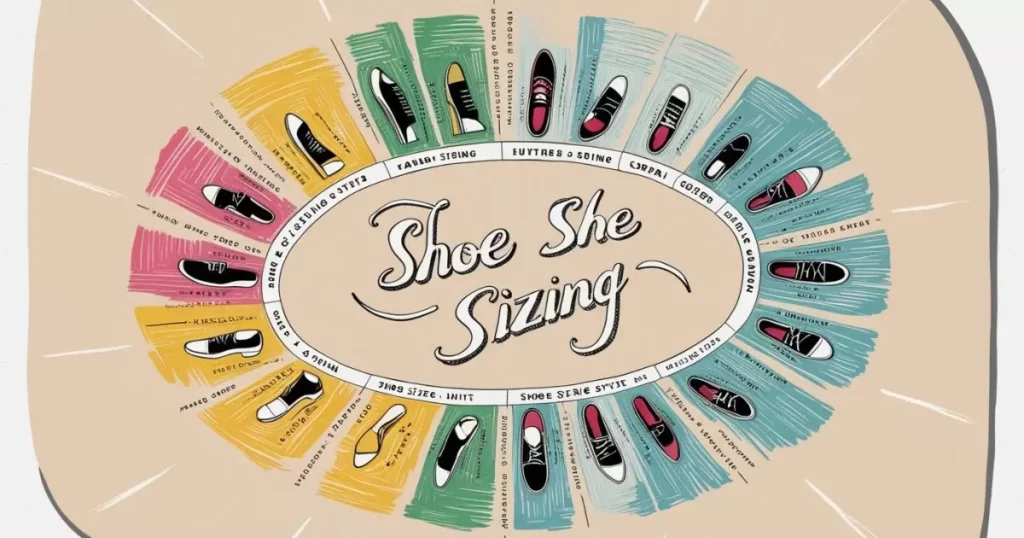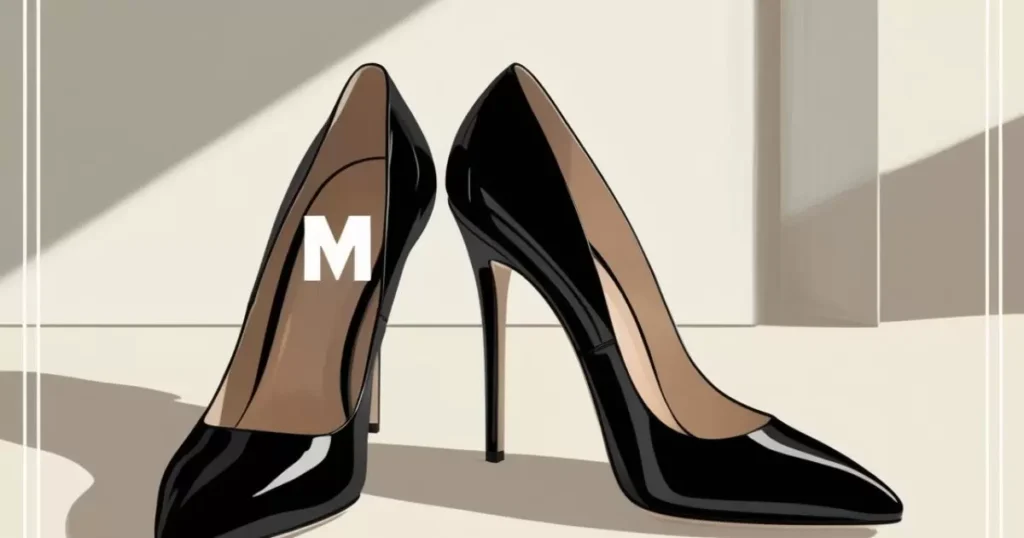Have you ever found yourself puzzled by the seemingly cryptic letters on shoe size labels? You’re not alone. The world of shoe sizing can be a labyrinth of numbers, letters, and symbols. Today, we’re going to unravel one of the most common yet confusing elements: the mysterious “M” in shoe sizes.
Let’s embark on a journey through the intricate world of footwear sizing, focusing on that enigmatic “M” and what it means for your feet. Whether you’re a shoe enthusiast or simply someone who wants to find the perfect fit, this guide will help you navigate the complexities of shoe sizing with confidence.
The ABCs of Shoe Sizing
Before we dive into the specifics of “M” in shoe sizes, let’s take a step back and look at the bigger picture of shoe sizing.
A Brief History of Shoe Sizing
Believe it or not, standardized shoe sizing has a rich history dating back to ancient times. The first known shoe size system was created by King Edward II of England in 1324. He decreed that three barleycorns (grains) placed end-to-end would equal one inch, and this became the basis for shoe sizing.
Fast forward to the 19th century, and we see the emergence of more sophisticated sizing systems. In 1880, the United States adopted a standard sizing system based on the length and width of the foot. This system, with some modifications, is still in use today.
Why Standardization Matters
Standardization in shoe sizing is crucial for several reasons:
- Consistency: It allows manufacturers to produce shoes that fit a wide range of feet.
- Consumer convenience: Shoppers can buy shoes with confidence, knowing their size is consistent across brands.
- Health: Proper fitting shoes are essential for foot health and overall comfort.
- Global trade: Standardization facilitates international shoe trade and online shopping.
Global Shoe Sizing Systems: A Comparative Look

Now that we understand the importance of shoe sizing, let’s explore how different parts of the world approach this task.
US Shoe Sizing Explained
The US shoe sizing system is perhaps the most complex, incorporating both length and width measurements.
Length
US shoe sizes are based on the length of the foot, with each half size representing about 1/6 of an inch difference. Here’s a quick reference table:
| US Men’s Size | US Women’s Size | Foot Length (inches) |
|---|---|---|
| 7 | 8.5 | 9 5/8 |
| 8 | 9.5 | 10 |
| 9 | 10.5 | 10 3/8 |
| 10 | 11.5 | 10 3/4 |
Width Indicators
This is where our friend “M” comes into play. In the US system, width is indicated by letters:
- N: Narrow
- M: Medium (our focus today!)
- W: Wide
- XW: Extra Wide
UK Shoe Sizing: Similar Yet Different
The UK system is similar to the US system but with some key differences:
- UK sizes are typically one size smaller than US sizes.
- The UK system uses a different scale for men’s and women’s shoes.
- Width is often indicated by letters, but “M” is not commonly used.
European Shoe Sizing: The Continental Approach
European shoe sizing takes a different approach altogether:
- It uses the Mondopoint system, based on the length of the foot in millimeters.
- Sizes typically range from 35 to 48.
- Width is not usually indicated by letters but by separate numerical scales.
Unraveling the “M” Mystery
Now that we’ve laid the groundwork, let’s focus on the star of our show: the “M” in shoe sizes.
“M” in US Shoe Sizes: Medium Width
In the US shoe sizing system, “M” stands for Medium width. But what does that really mean?
For men:
- An “M” width is equivalent to a D width.
- It’s considered the standard width for men’s shoes.
For women:
- An “M” width is equivalent to a B width.
- It’s considered the standard width for women’s shoes.
Here’s how “M” compares to other width options:
| Width | Men’s Equivalent | Women’s Equivalent |
|---|---|---|
| Narrow | B | A |
| Medium (M) | D | B |
| Wide | EE | D |
| Extra Wide | 4E | 2E |
Case Study: John’s Shoe Dilemma
John always bought size 10M shoes, assuming M meant “male.” He constantly struggled with tight shoes until a knowledgeable salesperson explained that M meant “medium width.” John discovered he actually needed a 10W (wide) for a comfortable fit.
“M” in UK Shoe Sizes: Does It Exist?
Interestingly, the UK system doesn’t typically use “M” as a width indicator. Instead, they use a different set of letters:
- F: Narrow
- G: Standard (equivalent to US M)
- H: Wide
When converting from US sizes to UK, an “M” width would generally translate to a “G” width.
European Shoes and the “M” Conundrum

European shoe sizing doesn’t use letter indicators for width. Instead, they may use terms like:
- Schmale Weite (Narrow)
- Normale Weite (Medium/Standard)
- Weite Weite (Wide)
When shopping for European shoes, a US “M” width would typically correspond to “Normale Weite.”
Beyond “M”: Other Width Indicators You Should Know
While “M” is a common width indicator, it’s important to be familiar with other width options:
- Narrow (N, A, B)
- Suited for feet with a slimmer profile
- Often preferred by people with low arches
- Wide (W, D, E)
- Ideal for feet that are broader than average
- Common among people with high arches or those who need extra room
- Extra Wide (XW, EE, EEE)
- Designed for significantly wider feet
- Often recommended for people with foot conditions like bunions
“Finding the right shoe width is just as important as finding the right length. It can make the difference between comfort and pain.” – Dr. Jane Smith, Podiatrist
Measuring Your Foot: The Key to Perfect Fit
Knowing your correct shoe size, including width, is crucial for comfort and foot health. Here’s a step-by-step guide to measure your foot accurately:
- Gather materials: You’ll need paper, a pencil, and a ruler.
- Trace your foot: Place your foot on the paper and trace around it.
- Measure length: Measure from the heel to the longest toe.
- Measure width: Measure across the widest part of your foot.
- Repeat: Do this for both feet, as they may differ in size.
- Compare: Use a shoe size chart to find your size and width.
Common mistakes to avoid:
- Measuring at the wrong time of day (feet swell as the day progresses)
- Not accounting for both feet
- Forgetting to wear socks if you plan to wear them with the shoes
The Art of Finding Your Perfect Shoe Size
Finding the perfect shoe size is more than just knowing your measurements. Here are some tips to ensure you always get the right fit:
- Brand variations: Remember that sizes can vary between brands. Always check the brand’s specific size chart.
- Online shopping tips:
- Read customer reviews for insights on fit
- Look for brands that offer free returns
- Consider ordering multiple sizes to try on at home
- When to consider custom-sized shoes:
- If you consistently struggle to find comfortable shoes
- If you have significant size differences between your feet
- If you have specific foot conditions that require special accommodation
The Future of Shoe Sizing

The world of shoe sizing is evolving with technology. Here are some exciting developments:
- 3D foot scanning technology
- Many shoe stores now offer 3D foot scans for precise measurements
- This technology can create a detailed map of your foot, including arch height and pressure points
- AI-powered size recommendations
- Online retailers are using AI to suggest sizes based on your purchase history and other customers’ experiences
- These systems can learn and improve over time, potentially leading to more accurate size predictions
FAQS
Q: What does “M” stand for in shoe sizes?
A: In shoe sizes, “M” stands for Medium width. It’s the standard width for most shoes in the US sizing system.
Q: Is “M” width the same for men’s and women’s shoes?
A: No, it’s not. In men’s shoes, “M” (Medium) is equivalent to a D width. In women’s shoes, “M” is equivalent to a B width.
Q: How does “M” width compare to other width options?
A: “M” is in the middle of the width spectrum. It’s wider than Narrow (N) but narrower than Wide (W) or Extra Wide (XW).
Q: Do all countries use “M” to indicate medium width in shoe sizes?
A: No, they don’t. While “M” is common in US sizing, the UK system typically uses “F” or “G” for standard width, and European sizes often don’t use letter indicators for width at all.
Q: If I usually wear “M” width shoes, should I always buy “M” in every brand?
A: Not necessarily. Shoe sizes and widths can vary between brands. It’s best to try on shoes or check each brand’s specific sizing guide, especially when shopping online.
Conclusion
Understanding what “M” means in shoe size is crucial for finding the perfect fit. We’ve learned that “M” stands for medium width in US shoe sizing, but it’s interpreted differently for men’s and women’s shoes. This knowledge can save you from the discomfort of ill-fitting footwear and help you shop for shoes more confidently, whether in-store or online.
Remember, shoe sizing isn’t just about length – width matters too. By knowing what “M” means in shoe size and how it relates to other width indicators, you’re better equipped to choose shoes that truly fit your feet. Whether you have narrow, medium, or wide feet, this understanding will guide you towards more comfortable and supportive footwear choices. meta Discover what “M” means in shoe sizes. Learn about width designations, their importance for comfort, and how to find the perfect fit for your feet. eading

An author is a creator of written content, producing works ranging from books and articles to blog posts and essays. They use their creativity, knowledge, and research to inform, entertain, or persuade readers. Authors often have a unique voice and perspective, contributing significantly to literature and various media.

